Related Research Articles

The 1954–1968 civil rights movement in the United States was preceded by a decades-long campaign by African Americans and their like-minded allies to end legalized racial discrimination, disenfranchisement and racial segregation in the United States. The movement has its origins in the Reconstruction era during the late 19th century, although it made its largest legislative gains in the mid-1960s after years of direct actions and grassroots protests. The social movement's major nonviolent resistance and civil disobedience campaigns eventually secured new protections in federal law for the human rights of all Americans.

Harlem is a neighborhood in Upper Manhattan, New York City. It is bounded roughly by Frederick Douglass Boulevard, St. Nicholas Avenue, and Morningside Park on the west; the Harlem River and 155th Street on the north; Fifth Avenue on the east; and Central Park North on the south. The greater Harlem area encompasses several other neighborhoods and extends west to the Hudson River, north to 155th Street, east to the East River, and south to Martin Luther King Jr. Boulevard, Central Park, and East 96th Street.
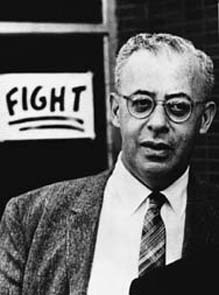
Saul David Alinsky was an American community activist and political theorist. His work through the Chicago-based Industrial Areas Foundation helping poor communities organize to press demands upon landlords, politicians and business leaders won him national recognition and notoriety. Responding to the impatience of a New Left generation of activists in the 1960s, in his widely cited Rules for Radicals: A Pragmatic Primer (1971) Alinsky defended the arts both of confrontation and of compromise involved in community organizing as keys to the struggle for social justice.

The Student Nonviolent Coordinating Committee was the principal channel of student commitment in the United States to the civil rights movement during the 1960s. Emerging in 1960 from the student-led sit-ins at segregated lunch counters in Greensboro, North Carolina, and Nashville, Tennessee, the Committee sought to coordinate and assist direct-action challenges to the civic segregation and political exclusion of African Americans. From 1962, with the support of the Voter Education Project, SNCC committed to the registration and mobilization of black voters in the Deep South. Affiliates such as the Mississippi Freedom Democratic Party and the Lowndes County Freedom Organization in Alabama increased dramatically the pressure on federal and state government to enforce constitutional protections.

Jerome Patrick Cavanagh was an American politician who served as the mayor of Detroit, Michigan from 1962 to 1970. Initially seen as another John F. Kennedy, his reputation was doomed by the 1967 riots. He was the first mayor to reside at Manoogian Mansion, donated to the city by the industrial baron Alex Manoogian.
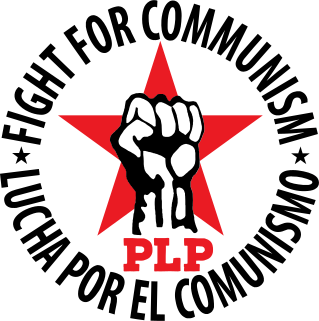
The Progressive Labor Party (PLP) is a Marxist–Leninist political party based primarily in the United States. The PLP is an anti-revisionist communist organization. It was established in January 1962 as the Progressive Labor Movement following a split in the Communist Party USA, adopting its new name at a convention held in the spring of 1965. It was involved in the anti-Vietnam War movement of the 1960s and early 1970s through its Worker Student Alliance faction of Students for a Democratic Society.

Across 110th Street is a 1972 American action crime film directed by Barry Shear and starring Yaphet Kotto, Anthony Quinn, Anthony Franciosa and Paul Benjamin. The film is set in Harlem and takes its name from 110th Street, the traditional dividing line between Harlem and Central Park that functioned as an informal boundary of race and class in 1970s New York City.
The Black Autonomy Network Community Organization (BANCO) is a political and social justice coalition working in Benton Harbor, Michigan, US. It was founded by Edward Pinkney to protest the June 16, 2003 death of a 28-year-old African-American, Terrance Shurn, while being pursued by Benton Township police. A riot followed the death, as accounts differed as to whether Shurn had lost control of his motorcycle or had been forced off the road by police.
Harlem Youth Opportunities Unlimited, more commonly called HARYOU, was an American social activism organization founded by psychologists Kenneth Clark and Mamie Phipps Clark in 1962. Its director was Cyril deGrasse Tyson, father of astrophysicist Neil deGrasse Tyson, and founding member of the 100 Black Men of America. The group worked to increase opportunities in education and employment for young blacks in Harlem. It also was designed to teach residents of Harlem how to work with governmental agencies to meet their demands.
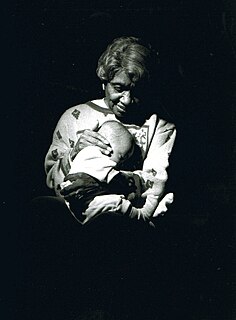
Clara McBride Hale, also known as Mother Hale, was an American humanitarian who founded the Hale House Center, a home for unwanted children and children who were born addicted to drugs.
The Near North Side of Omaha, Nebraska is the neighborhood immediately north of downtown. It forms the nucleus of the city's African-American community, and its name is often synonymous with the entire North Omaha area. It is bordered by Cuming Street on the south, 30th on the west, 16th on the east, and Locust Street to the north.

The Harlem riot of 1964 occurred between July 16 and 22, 1964. It began after James Powell, a 15-year-old African American, was shot and killed by police Lieutenant Thomas Gilligan in front of Powell's friends and about a dozen other witnesses. Immediately after the shooting, about 300 students from Powell's school who were informed by the principal rallied. The shooting set off six consecutive nights of rioting that affected the New York City neighborhoods of Harlem and Bedford-Stuyvesant. In total, 4,000 New Yorkers participated in the riots which led to attacks on the New York City Police Department (NYPD), vandalism, and looting in stores. Several protesters were severely beaten by NYPD officers. At the end of the conflict, reports counted one dead rioter, 118 injured, and 465 arrested.
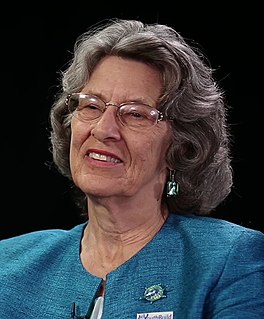
Dorothy Stoneman is the founder and former CEO of YouthBuild USA, Inc. and former chairman of the YouthBuild Coalition, with over 1,000 member organizations in 45 states, Washington, D.C. and the Virgin Islands. She has been widely recognized for her contributions to the civil rights movements, poverty elimination efforts, and the emergence of the youth development field in the United States. Among the numerous awards she has received, Stoneman was awarded a MacArthur "genius" Fellowship (1996), and the Skoll Award for Social Entrepreneurship (2007).

Founded in the 17th century as a Dutch outpost, Harlem developed into a farming village, a revolutionary battlefield, a resort town, a commuter town, a center of African-American culture, a ghetto, and a gentrified neighborhood.
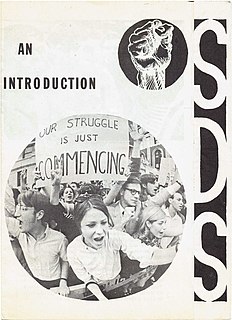
Students for a Democratic Society (SDS) was a national student activist organization in the United States during the 1960s, and was one of the principal representations of the New Left. Disdaining permanent leaders, hierarchical relationships and parliamentary procedure, the founders conceived of the organization as a broad exercise in "participatory democracy." From its launch in 1960 it grew rapidly in the course of the tumultuous decade with over 300 campus chapters and 30,000 supporters recorded nationwide by its last national convention in 1969. The organization splintered at that convention amidst rivalry between factions seeking to impose national leadership and direction, and disputing "revolutionary" positions on, among other issues, the Vietnam War and Black Power.
National Rural Livelihood Mission (NRLM) is a poverty alleviation project implemented by Ministry of Rural Development, Government of India. This plan is focused on promoting self-employment and organization of rural poor. The basic idea behind this program is to organize the poor into SHG groups and make them capable for self-employment. In 1999 after restructuring Integrated Rural Development Programme(IRDP), Ministry of Rural Development (MoRD) launched Swarnajayanti Grameen Swarojgar Yojana (SGSY) to focus on promoting self-employment among rural poor. SGSY is now remodeled to form NRLM thereby plugging the shortfalls of SGSY programme. This program was launched in 2011 with a budget of $5.1 billion and is one of the flagship programs of the Ministry of Rural Development. This is one of the world's largest initiatives to improve the livelihood of poor. This program is supported by the World Bank with a credit of $1 Billion. The program was succeeded by Deen Dayal Antyodaya Yojana on 25 September 2015.
The Watts Labor Community Action Committee (WLCAC) is a non-profit, 501 (c) 3 organization incorporated in the State of California, in 1965. Its mission "is to improve the quality of life for the residents of Watts and neighboring communities."

The Bedford Stuyvesant Restoration Corporation is a community development corporation based in Brooklyn, New York, and the first ever to be established in the United States.
African Americans constitute one of the longer-running ethnic presences in New York City. The majority of the African American population were sold from their villages in West and Central Africa and brought to the American South via the Atlantic slave trade.
Floria Pinkney was a Progressive Era garment worker and union activist from Brooklyn, New York. She was the first African-American woman to hold a leadership role as an organizer within the International Ladies Garment Workers Union.
References
This article relies largely or entirely on a single source .(February 2008) |